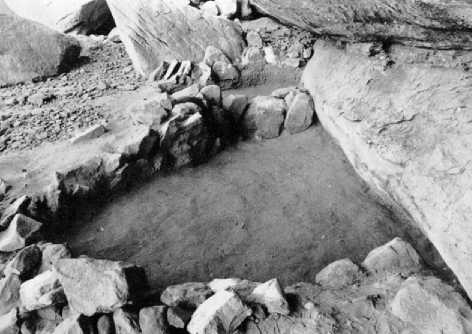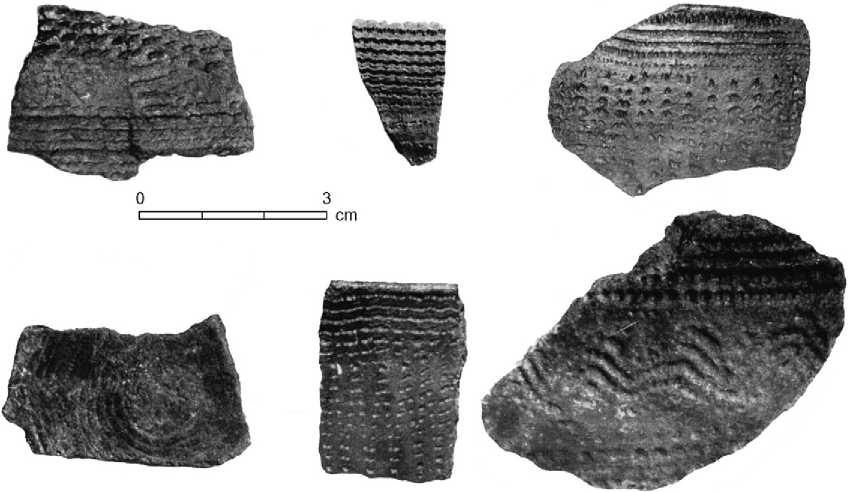The Wiirm glaciation is evident throughout the large extent of the Sahara as a long arid episode, which reached its peak around 20 000 years ago, causing a severe contraction of human occupation, if not a complete abandonment of the area by human groups. In the Sahara, therefore, the beginning of a marked transformation in lifestyle, a prelude to food production activities, coincided with the return of the rains at the end of Pleistocene (12 000-10 000 BP) and with the resettlement of the region. In the transitional phase between the Pleistocene and the Holocene, cultural groups were strongly based on the exploitation of aquatic resources, a life style that the archaeologist Sutton called ‘aqualithic culture’. In Mali a lacustrine phase, between 8500 and 6900 BP, can be seen in the stratigraphic sections of the ancient lakes that lie next to the extensive dunes. Finely stratified sediments, which contain the remains of aquatic fauna, shells, and diatoms (freshwater plants), are clear signs of the presence of permanent lakes in the past. The huge cemeteries that have been discovered in the Taoudenni region (Hassi el Abiod, Ine Sakane) have permitted notable observations to be made regarding, in particular, palaeoanthropological characteristics. An important cultural sequence is also evident in the mountainous regions of Algeria, where hunter-gatherer groups left remains of their material culture, in particular a characteristic pottery type, in temporary camps such as Amekni and Ti-n-Hanakaten. Other human settlements in the central Sahara appear in the area of the modern state of Chad, but are only known from surface scatters and ceramics collected by French and German archaeologists.
In contrast, in Libya and Niger there are full stratigraphic sequences that allow the transformation of lifestyle to be studied: from a wide range of environmental exploitation strategies (including hunting, gathering, and fishing activities) to an economy that was specialized in pastoralism (cattle, sheep/goat). The Tadrart Acacus Massif in Libya that, along with the Algerian Tassili n’Ajjer, is one of the most important rock art (see Rock Art) complexes in the Sahara, has provided the various phases in this sequence, allowing light to be shed on the initial stages of domestication, which is not always visible in archaeological research. The lower layers (c. 9100 BP) of Ti-n-Torha East, in northern Acacus, show occasional occupation and a wide range of environmental exploitation strategies - with a strong incidence of plant food linked to the first appearance of ceramics (Figure 2). Other sites, such as Uan Afuda and Uan Tabu, show instead a lesser interest in the exploitation of floral resources and, on the other hand, a greater specialization in the exploitation of fauna. For example, Uan Afuda was laid out as a specialized camp for Barbary sheep (Ammotragus lervia) hunting and herding. In the upper layers (8500-8000 BP), Ti-n-Torha East becomes a real proto-village, with a series of hut foundations built against the rock walls of the wadi that was suitable for the needs of a semi-permanent settlement (Figure 3). The composite sequence obtained from the three sites of Ti-n-Torha (East, North, and Two Caves Shelters) covers the entire period from Early to Middle Holocene (Figure 4). On the basis of material culture and archaeozoolo-gical evidence, the author suggests an autochthonous transition model (i. e., a local development model, without external influences) from pre-domestication to forms of incipient domestication.
The Libyan situation finds notable parallels, stratigraphic and chronological, to the situation seen in Niger. The first discoveries made here, in the Air region, were by J. Desmond Clark in the 1970s. A full reconstruction of the regional sequence is due to the subsequent research of J. P. Roset who, in the 1980s, made

Figure 3 The Ti-n-Torha East settlement (Libya). From Barich BE (1998) People, Water and Grain - The Beginnings of Domestication in the Sahara and the Nile Valley. Rome: L’Erma di Bretschneider.

Figure 2 Ceramics with impressed decorations from Ti-n-Torha East (Libya). Photo Barbara Barich, unpublished.
Known the more-or-less contemporary sites of Temet 1 (9650-9450BP), Ti-n-Ouaffadene (9360-9080BP), and Adrar Bous 10 (9220-8840 BP), which are all tied to the lake expansion in the wet phase of the Early Holocene. The lithic complex of these contexts, as seen in Temet 1, continues the Epipalaeolithic tradition which, however, is already associated with pottery. The oldest examples have been found in Tagalagal, in the Bagzanes mountains (Air) and dated to between 9500 and 9200 BP. The Tagalagal ceramics have a variety of forms and well-developed decoration. Among these the ‘dotted wavy line’ decoration is noteworthy, as it is the most characteristic motif of the
Saharan ceramic production in the Early Holocene. The faunal remains found have been attributed to wild animals and even fish, while the abundance of grinding stones is evidence of the importance of plant gathering.
Hydrogeological studies in Niger have shown that an initial climatic recovery with the return of the rains, came at the end of the Pleistocene, around 13 000 years ago. It was then followed by a further dry phase in 9500 BP, just at the beginnings of the Holocene sequence. These data give support to the existence in Niger of a Palaeolithic (or Epipalaeo-lithic) occupation phase, as had been suggested by J. Desmond Clark.




 World History
World History









